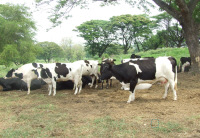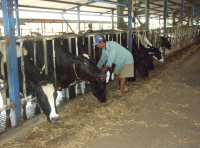



Aspects of Asian Dairying
In the past, Asians have not been large consumers of milk, but things are changing, writes Stuart Lumb for TheDairySite.China is the world’s 3rd largest dairy nation, despite her national milk consumption being about 25 per cent of the world average. Consumption is only in the region of 25 litres per person per year, and was increasing rapidly.
However the melamine scandal resulted in a big drop in milk prices and consumption plus caused many dairy farmers to go out of business. Dr Dong is a veterinary consultant working with French company Olmix and he knows a great deal about the Chinese dairy industry. Most of the cows in China are located in the cooler northern region, in Heilongjiang, Shangdong and Xinjiang provinces. Winters can be severe and last 4 months in these northern parts of China.
With regard to breed, Holsteins predominate, with many lines being imported from New Zealand, USA and Canada. Many farmers have only 4 or 5 cows , with around 30 per cent of herds having 20 cows or more. The average lactation is around 4,500 litres with better herds achieving around 6,500 litres. Herring bone parlours are quite popular and many of the larger farms feed maize silage. Twice a day milking is the norm, although some big farms milk three times a day.
According to Dr Dong mastitis and laminitis are the two most common problems that he comes across. Milk is processed through 1,600 dairies, or milk companies as they are known in China.
Thailand has around 300,000 milking cows, mainly Holstein/Brahman crosses, with the average dairy farm having between 15-30 cows. Cows are loose housed on concrete which results in leg problems, commented Dr Philippe Arzul, veterinary consultant with French feed company Vitalac. The cows are bucket milked twice daily and give 10-15kg per day.
These low yields mean that mastitis is not a problem. Concentrates are fed twice a day at milking and are supplemented with rice straw, which is not particularly nutritious. The milk is taken to collection centres and from there is transported to dairies. Currently Thai dairymen are making money. However investment in buildings and buildings is poor. Farmers need to increase the herd size but this is limited by land availability and lack of quality forage.
Politics impact in Thailand just as anywhere else in the world. Currently Thai dairy producers are “up arms”about a national school milk scheme. The government is investing £173,000 to ensure school children receive milk at school and so improve their nutrient intake. What is incensing Thai dairymen is that entrepreneurs are selling milk to the schools made from imported milk powder which costs half the price of liquid milk sourced from Thai dairies.
The Muak Lek dairy complex stands 800m above sea level in the Thai province of Saraburi. This altitude means the ambient temperature is naturally cooler than it would have been had the centre been based at sea level. Muak Lek was set up as a joint venture between the Danish and Thai governments back in 1962, in order to train Thai farmers in dairy skills and to boost the national milk output.

In 1971 Muak Lek was taken over by the Dairy Farming Promotion Organisation of Thailand (DPO). The original imports of Danish Red cows had trouble with the heat and so were crossed with the Sahiwal and Red Sindi breeds, both originating from Pakistan. Now Holsteins are the preferred breed as they can cope with the heat and humidity.
Brucellosis and TB are not a problem but mastitis and lameness are. In an effort to reduce lameness special walkways have been constructed between the milking sheds and the pastures. Adult cattle are resistant to Tick Fever. Pastures are sprayed every two weeks and calves grazing the pastures develop immunity.
The herd at Muak lek comprises 170 dairy cows , very large by Thai standards. These cows have open sheds to lie under to gain respite from the heat. March is part of the Thai dry season and so the cows are fed silage made from grass and sorghum. The pastures are not irrigated as the water table is dropping. Water reserves are being depleted due to the demands for water to cater for tourists and golf courses. Which should take priority though ? Even tourists drink milk …
Cows are milked twice a day, at 6.30am and 3.30pm , using a bucket system and a vacuum line. Test results on cows with suspected mastitis are turned round in 4 hours and any positive cows are treated accordingly and the milk withdrawn from the food chain. The average Somatic Cell Count (SSC) is around 400,000 cells/ml. The SSC tends to be high during the rainy season (June- August) and low in the dry season ( March-May). According to Dr Chockchai Chaimongkol, the centre’s director, “Cleanliness problems result in high SCCs. The average 300 day lactation yield is 3,800 litres . Currently we are receiving 32p / litre , with our costs of production standing at 26p.
The centre which is also a member of the local cooperative has an AI stud of 30bulls, with Holstein semen being imported from the USA and New Zealand . Inseminators travel the locality providing an AI service for coop members.
Muak Lek also has a milk processing facility, operated by DPO. This facility processes 220 tons of milk per day and operates round the clock , shutting down each Thursday to allow essential maintenance to be carried out. Whilst looking round the plant Dr Chiamongkol pointed at the milk tankers and explained that written on the rear of the tank in large letters are the words “Liquid Milk – NO melamine”. The plant produces UHT milk in 125ml cartons and 200ml blister packs, but this still needs refrigerating ( a fridge can be bought for £25). A variety of flavoured yoghurts are also produced, with all the products being sold under the “Red Cow” label. The link with Denmark is there for all the public too see!

Over the years the DPO has managed to increase the number of dairy cattle owned by its members from just under 3,500 head in 1971 to over 95,000 currently. Milk production has increased correspondingly. The DPO operates 5 processing plants including the Muak Lek one, which is by far the largest. In 2008 the plants manufactured a grand total of 104,008 tons of dairy products, comprising 89,906 tons of UHT milk, 13,472 tons of pasteurised milk, 323 tons of drinking yoghurt, 150 tons of yoghurt and 157 tons of other dairy products.
The DPO as an agricultural organisation is having to face up to several problems, some of them very familiar to farmers elsewhere in the world . The organisation has not received any government backing since 1980 and makes a plea for funding in order to finance further expansion. There is a big demand for cross bred dairy cows which is not being met and consequently heifers command very high prices which is impacting on profitability individual dairy farms.
There are several organisations responsible for national dairy development , namely the DPO, the Dept of Livestock Development (DLD) and the Cooperatives Promotion Dept(CPD), all with different objectives. For instance the DPO is encouraging marketing whereas the DLD is promoting just milk production. Also private milk processors are offering higher prices to farmers for their milk but unlike DPO do not provide an AI or veterinary service.
Even Thailand is struggling to attract staff to work in her dairy sector. DPO officials are complaining about a lack of new vets, inseminators and even dairy processing workers. This lack of personnel is seriously hampering the expansion of the DPO and along with it impeding an increase in the national dairy herd and consequently national milk production.
Vietnam’s national dairy herd stands at around 100,000 cows. Many are straight 50/50 Holstein /Brahman , others are 50-80 per cent Holstein. A typical dairy farm has 30 cows and is very labour intensive. The cows are kept tied up in stalls for most of the time but are let out and exercised twice per day. The floors are concrete, no bedding is used so foot and leg problems are common. Despite a lack of bedding the cows are very clean as they are washed twice a day. Feeding is based on brewer’s grains and elephant grass.
The elephant grass is not very nutritious and is cut every 45 days, although cutting every 30 days increases its feed value and hence milk yields. Bucket milking is again the norm and after filtering the milk is poured into plastic containers which are transported by motor bike and trailer to the local dairy.
There are some larger dairy herds where the cows are loose housed, but again milked with bucket systems. The best Holstein crosses will produce up to 30 litres of milk per day. Some farmers have tried 15/16 Hostein crosses but the heat stressed them out and infertility was also a problem . Frozen semen is imported from the USA. On one of the largest farms ( 130 cows) one person looks after 11 cows, very labour intensive by Western standards, but then again grass is cut by hand and feeding is also not mechanized. As far as feeding is concerned, during the rainy season (May-Nov ) cows are fed cut grass and concentrates( 40kg grass plus 0.4kg concs/litre). Brewer’s grains are fed as and when available. Grass silage is made during the rainy season and fed during the dry season (Dec- April) along with urea- treated straw.


